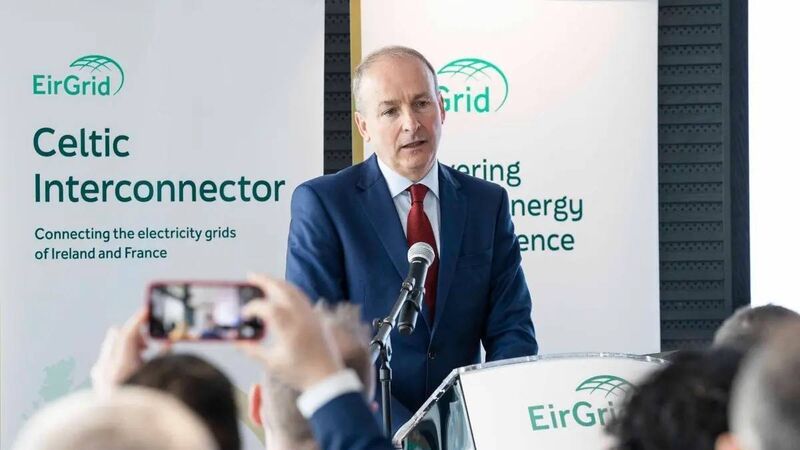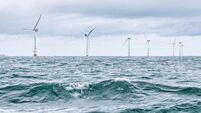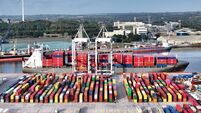Onshore energy auction unlikely to drive Ireland to its 2030 green goals

An Taoiseach Micheál Martin told reporters in New York that renewable energy developments are needed to meet surging demand for tech like AI. The image shows the Taoiseach addressing questions around EirGrid's Celtic Interconnector, a 700 MW high-voltage submarine power cable under construction between Ireland and Brittany.
The latest State-supported auction for onshore renewable projects was a last-ditch effort to achieve Ireland’s 2030 climate targets and the results provided a grim outlook.
The lacklustre results for the fifth Renewable Energy Support Scheme, or RESS5, showed a competition ratio of 1.5, making this auction is the least competitive since RESS2, which was held back in 2022.
"While the outcome of another high-cost, low-volume auction might be disappointing, it’s not unexpected given the persistent challenges facing renewables,” said Nick Civetta, project leader at Aurora Energy Research.
These State auctions have been mired by prolonged planning disputes, extended grid connection timelines, and constraints that continue to undermine the profitability of non-firm assets.
"This was the last auction with a realistic pathway to bring capacity online ahead of the 2030 target,” said Mr Civetta.
Aurora forecasted that 2.6GW of capacity was eligible for the auction, however, just 1.5GW participated, signalling persistent issues with planning and grid constraints that impact project economics and timings.
“With future auctions likely to have longstop dates beyond 2030, the limited volume secured here suggests that onshore renewables may now struggle to meet the 80% renewables generation target on their own,” said Mr Civetta.
Through RESS5, Ireland bought 854MW of solar PV and 219MW of onshore wind for an average strike price of €98.91/MWh.
Industry expert and VP for development and offshore at Statkraft Ireland Donal O’Sullivan noted that while the average contract price for wind increased slightly on the previous auction, the average price for solar decreased to €100.63.
“The gap is narrowing again between the technologies in Ireland. Both these prices are still very competitive versus the alternative for which is more imported fossil fuels,” he said.
In terms of prices felt by the consumer, onshore wind developments have become a cheaper source of new electricity for Irish households. A report published earlier this year found that, between 2000 and 2023, onshore wind farms saved Irish electricity consumers nearly €840m.
The ‘Protecting Consumers: Our onshore wind energy opportunity’ report commissioned by Wind Energy Ireland analysed Ireland’s geography, identifying the land available in the country for future development.
The mapping exercise identified roughly 1,302km2 of land on which wind farms could be built – less than 2 per cent of the Republic of Ireland. Conservative estimates suggest this would be enough to produce nearly 6,000 MW of onshore wind energy.
Assuming the 2030 Climate Action Plan target of 9,000MW is met, this additional capacity would treble Ireland’s current wind generation.
“To develop this enormous potential we need a well-resourced planning system which prioritises renewable energy and takes full advantage of changes in EU law designed to accelerate the development of wind power,” said Wind Energy Ireland chief executive Noel Cunniffe when the report was published.
“Supporting this, we must have a stronger, more robust, electricity grid which ensures the clean, affordable power from these wind farms gets to those who need it,” he added.
There have been significant developments in the Irish onshore renewables industry recently, indicating progress despite chronic headwinds.
In recent weeks, Danish renewable energy giant Ørsted installed the first turbines of its 22nd wind farm on the island of Ireland.
The Farranrory Onshore Wind Farm in Co Tipperary will eventually consist of nine Nordex N133 4.8 MW turbines and will provide the Irish grid with a 33.5km 110kV connection to Ballyragget substation in Co Kilkenny.
Farranrory Wind Farm is the first development in the world to incorporate road markers made from recycled turbine blades.
“Using recycled blades from our oldest wind farm to make marker posts for our newest wind farm brings the meaning of circular economy to the next level,” said VP of onshore Ireland and UK at Ørsted TJ Hunter.
Ørsted’s also recycled old blades from the recently retired Owenreagh 1 windfarm in Northern Ireland.
Once fully operational, the wind farm will have capacity to supply 43.2 MW of renewable electricity, which is enough to power up to 25,000 households.
The project was awarded a contract under the RESS3 auction in 2023 and is expected to be fully operational by the summer of 2026.
Elsewhere, Cork-based Ørsted Onshore Ireland is constructing 179.2 MW of additional renewable capacity in Ireland, including our first two Irish solar farms.
These projects combined will bring Ørsted’s operational capacity across solar power and onshore wind in Ireland and Northern Ireland to over 550 MW.
Ørsted has reiterated its commitment to Ireland through these projects, but has battled high costs and delays, forcing it to axe 25% of its workforce over the next two years.
The company said it will focus on offshore projects and its business operations in Europe in an effort to “improve its competitiveness”, as it veers away from deals in the US under US President Trump’s administration.
The company will cut around 2,000 positions towards the end of 2027. The layoffs are unlikely to directly impact Ireland, but add to growing concern for the renewable energy industry.
On the other hand, the Government’s overreliance on corporation tax and the companies responsible for it will drive up interest in the Irish market among onshore renewable energy developers.
In recent years, windfarms and solar parks have increasingly, and controversially, been used by Big Tech to power their energy-guzzling data centres through purchasing power agreements.
In Ireland, data centres account for over 20% of all electricity consumption, according to figures from the Central Statistics Office.
The growing relationship between renewable energy developers and Big Tech is somewhat of a double-edged sword for the Irish market.
Speaking to reporters in New York recently, Taoiseach Micheál Martin said renewable energy developments are needed to meet surging demand for tech like AI.
However, the growth of data centres could lead to considerable strain on local power networks, exacerbated by the huge mismatch between rapid data centre construction times and the often sluggish pace of expanding and strengthening grids and generation capacity, according to the IEA.
Grid capacity constraints are usually the most pressing issue for renewable energy developers, particularly in Dublin, the location for many large data centres. This limitation has led to connection moratoriums, potentially deterring future investment, a report by professional services firm PwC said.














